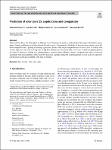Item Infomation
Full metadata record
| DC Field | Value | Language |
|---|---|---|
| dc.contributor.author | Penza, Valentina | - |
| dc.contributor.author | Bertello, Luca | - |
| dc.contributor.author | Cantoresi, Matteo | - |
| dc.date.accessioned | 2023-08-09T09:44:05Z | - |
| dc.date.available | 2023-08-09T09:44:05Z | - |
| dc.date.issued | 2023 | - |
| dc.identifier.uri | https://link.springer.com/article/10.1007/s12210-023-01184-y | - |
| dc.identifier.uri | https://dlib.phenikaa-uni.edu.vn/handle/PNK/8780 | - |
| dc.description | CC-BY | vi |
| dc.description.abstract | Solar activity affects the heliosphere in different ways. Variations in particles and radiation that impact the Earth’s atmosphere, climate, and human activities often in disruptive ways. Consequently, the ability to forecast solar activity across different temporal scales is gaining increasing significance. In this study, we present predictions for solar cycle 25 of three solar activity indicators: the core-to-wing ratio of Mg II at 280 nm, the solar radio flux at 10.7 cm—widely recognized proxies for solar UV emission—and the total solar irradiance, a natural driver of Earth’s climate. Our predictions show a very good agreement with measurements of these activity indicators acquired during the ascending phase of solar cycle 25, representing the most recent data available at the time of writing. | vi |
| dc.language.iso | en | vi |
| dc.publisher | Springer | vi |
| dc.subject | Earth’s atmosphere | vi |
| dc.subject | increasing significance | vi |
| dc.title | Prediction of solar cycle 25 applications and comparison | vi |
| dc.type | Book | vi |
| Appears in Collections | ||
| OER - Khoa học môi trường | ||
Files in This Item:

